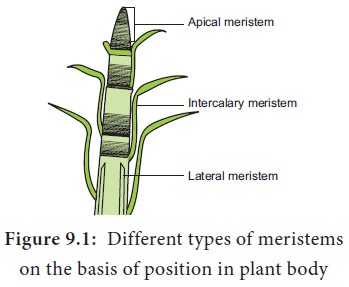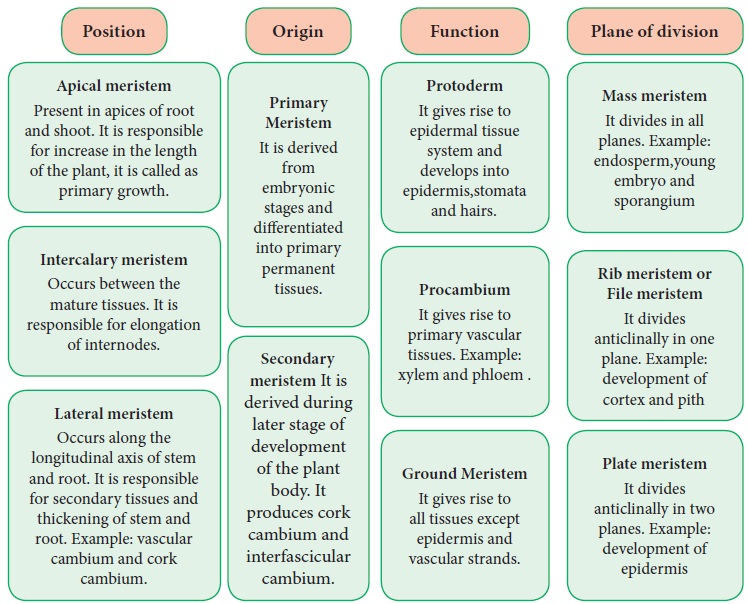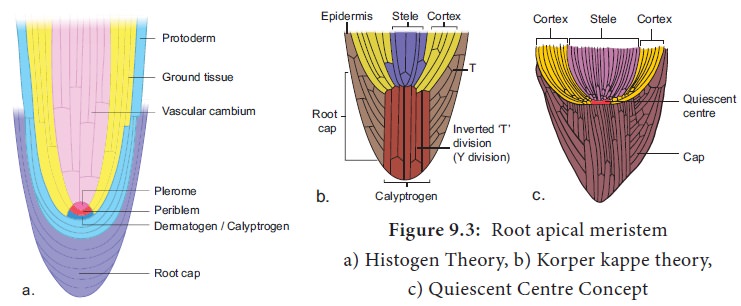Characteristics, classification, Theories - Meristematic Tissue | 11th Botany : Chapter 9 : Tissue and Tissue System
Chapter: 11th Botany : Chapter 9 : Tissue and Tissue System
Meristematic Tissue
Meristematic Tissue
Characteristics and classification
The characters of meristematic tissues:
(Gr. Meristos-Divisible)
·
The term meristem is coined by C. Nageli 1858.
·
The meristematic cells are isodiametric and they
may be, oval, spherical or polygonal in shape.
·
They have generally dense cytoplasm with prominent
nucleus.
·
Generally the vacuoles in them are either small or
absent.
·
Their cell wall is thin, elastic and essentially
made up of cellulose.
·
These are most actively dividing cells.
·
Meristematic cells are self-perpetuating.
Classification of Meristem
Meristem
has been classified into several types on the basis of position, origin,
function and division.


Theories of Meristem Organization and Function
Many
anatomists illustrated the root and shoot apical meristems on the basis
ofnumberandarrangementandaccordingly proposed the following theories – An
extract of which are discussed below.
Shoot Apical Meristem
Apical Cell Theory
Apical
cell theory is proposed by Hofmeister (1852)
and supported by Nageli (1859). A
single apical cell is the structural
and functional unit.

This
apical cell governs the growth and development of whole plant body. It is
applicable in Algae, Bryophytes and in some Pteridophytes.
Histogen Theory
Histogen
theory is proposed by Hanstein
(1868) and supported by Strassburgur.
The shoot apex comprises three distinct zones.
1.
Dermatogen:
It is a
outermost layer. It gives rise to
epidermis.
2.
Periblem:
It is a
middle layer. It gives rise to
cortex.
3.
Plerome: It is
innermost layer. It gives rise to
stele
Tunica Corpus Theory
Tunica
corpus theory is proposed by A. Schmidt (1924).
Two zones
of tissues are found in apical meristem.
a.
The
tunica: It is the peripheral zone of shoot
apex, that forms epidermis.
b.
The
corpus: It is the inner zone of shoot
apex,that forms cortex and stele of shoot.
Root Apical Meristem
Root apex
is present opposite to the shoot apex. The roots contain root cap

The different
theories proposed to explain root apical meristem organization is given below.
![]()
Apical Cell Theory
Apical
cell theory is proposed by Nageli.
The single apical cell or apical initial composes the root meristem. The apical
initial is tetrahedral in shape and produces root cap from one side. The
remaining three sides produce epidermis, cortex and vascular tissues. It is
found in vascular cryptogams.
Histogen Theory
Histogen
theory is proposed by Hanstein (1868) and supported by Strassburgur. The histogen theory as appilied to the root apical meristem speaks
of four histogen in the meristem. They are respectively
i.
Dermatogen:
It is a
outermost layer. It gives rise to
root epidermis.
ii.
Periblem:
It is a
middle layer. It gives rise to
cortex.
iii.
Plerome: It is
innermost layer. It gives rise to
stele
iv. Calyptrogen:
It gives
rise to root cap.
Korper Kappe Theory
Korper
kappe theory is proposed by Schuepp.
There are two zones in root apex –
Korper and Kappe
1.
Korper
zone forms the body.
2.
Kappe
zone forms the cap. This theory is
equivalent to tunica corpus theory of shoot apex.The two divisions are
distinguished by the type of T (also called Y divisions). Korper is characterised
by inverted T divisions and kappe by straight T divisions.
Quiescent Centre Concept
Quiescent
centre concept was proposed by Clowes
(1961) to explain root apical meristem activity. These centre is located
between root cap and differentiating cells of the roots. The apparently
inactive region of cells in root promeristem is called quiescent centre. It is
the site of hormone synthesis and also the ultimate source of all meristematic
cells of the meristem.
Related Topics